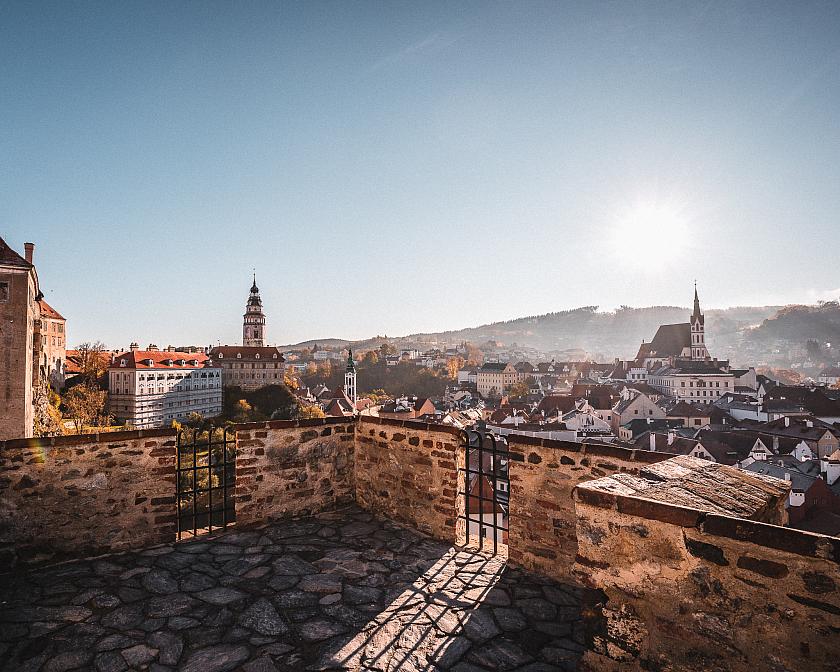Walks through the castle courtyards and garden
You simply cannot miss Krumlov Castle during your walks. Walking through the castle courtyards and the garden is always an experience as well as a bit of an exercise, as it is a few kilometre walk with a varied terrain – well it basically is not just flat. Castle courtyards are accessible all year round, the garden from April until Oktober.
The Red Gate
The walk begins at the Red Gate which is the entrance to the 1st courtyard from the Latrán Street.
Ist Courtyard
Enter the first courtyard (so called Rejdiště – Romping Ground) through the Red Gate from Latrán Street. The original grounds of the front part of the castle with ramparts and fortifications were converted into the built-up and busy farming estate during the building development towards the end of the 16th century. The history of the long building on the left hand side, today the Study Centre, is interesting. There were chateau stables for centuries, then, during the 1930s, it was converted into office space and an archive, and in 1938 the NSDAP headquarters moved here. The Column Hall on the ground floor was decorated with motifs of soldiers fighting under swastikas, and a two-meter statue of the imperial eagle stood in the niche. After 1948, the SNB (National Security Corps) settled here - the decorations changed in the spirit of socialist realism and the eagle in the niche was this time replaced by a bust of Klement Gottwald. Today, there is a centre designed for educational study visits, conferences or cultural events.
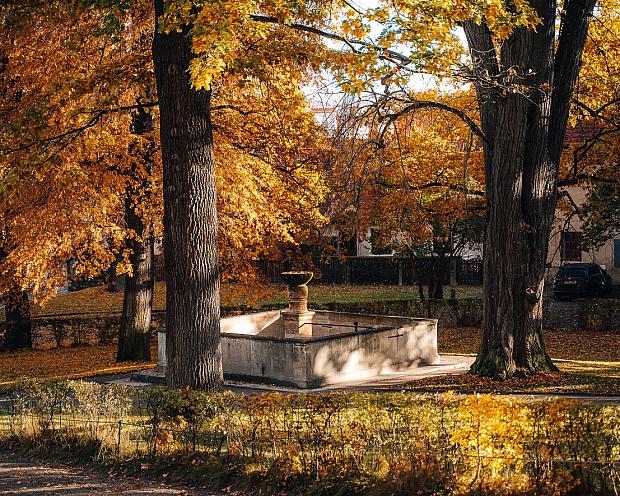
IInd Courtyard
As we walk towards the IInd courtyard, we walk above a deep castle moat over a stone bridge, which replaced the original wooden draw-bridge in 1647. Don’t forget to greet the three castle bears – Marie Terezie, Vilém and Polyxenie. Bears have been kept in the castle moat since the 16th century as living proof of a presumed relation between the Lords of Rosenberg and the Italian family of Orsini (orso in Italian = bear).
The present-day IInd courtyard covering the grounds of the original so-called Lower Castle is currently an entry point for the tower and the Castle museum. It is the New Burgrave’s House – the gray, two-winged building that will immediately draw your attention. It is a building from the 2nd half of the 16th century with so called chiaroscuro Renaissance facade wall paintings. From 1742 to 1949, the building was used, among other things, as the Schwarzenberg Guard barracks. The remnants of this era are represented by the four cannons, the oldest of which dates back to 1608.
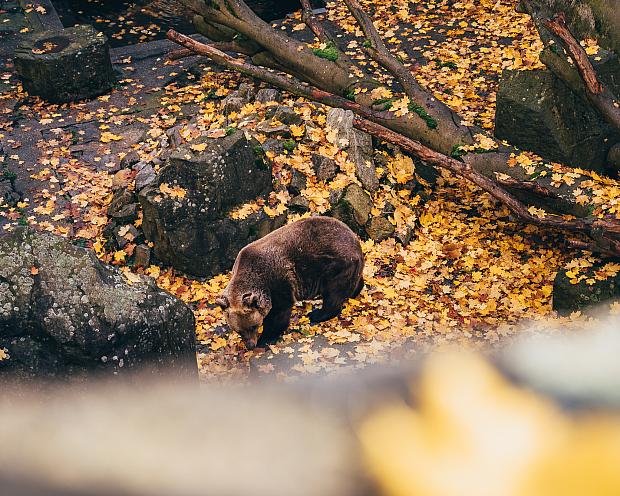
We climb to the third castle courtyard through an arched corridor, which had been commissioned and built as an entrance to the Upper Castle by William of Rosenberg (1535-1592). A set of palace buildings forming the Upper Castle and surrounding the IIIrd and the IVth courtyards of the chateau was created in individual construction stages from the middle of the 14th to the 18th century. The buildings have preserved their Renaissance character from the time of their greatest prosperity in the second half of the 16th century. There is an interesting fact: there are multi-storey vaulted cellars (accessible during the visitor season) on the modified rock massif, under the courtyard, built as a reliable foundation for the walls of the palace and reaching a height of several tens of meters. The paintings of the facades of both courtyards from the end of the 16th century depict scenes and personalities from Greek and Roman history. Count all real and illusory (painted) windows on the IIIrd courtyard with your kids. How many did you find?
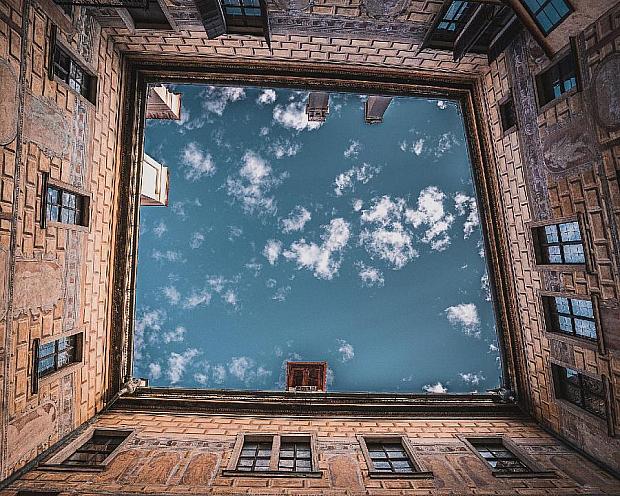
Vth Courtyard
To get to the Vth courtyard of the chateau, we have to walk over the so-called Cloak Bridge, one of the dominating features of Český Krumlov, a technically daring and impressive work. The open part of the bridge connects the fourth and fifth castle courtyards, above it there are two corridors. On the lower floor, it connects the Masquerade Hall with the chateau Baroque Theatre, the upper corridor allows us to walk all the way to the castle gardens. When walking in the opposite direction, it was possible to go through the trusses of the chateau all the way to the monastery. Today's appearance of the bridge dates back to 1777.
The Vth courtyard, originally created by fortifications and farm buildings, remarkably changed its character in 1681 when the theatre building was set up. The stone terraces levelling out the terrain and fortifications offered suitable grounds for building expansion towards the west. In 1684, Prince Johann Christian I. von Eggenberg had the theatre built there. The chateau's Baroque Theatre is unique on an international scale - in the integrity of its original equipment, a demonstration of an advanced Baroque scene (auditorium, stage, stage technology, scenery, costumes, props, lighting equipment) has been preserved, as well as in the rich archival documentation of the repertoire.
The iron gate with the building of Porter's Lodge closes in the Vth courtyard of the castle complex. Other buildings are situated in the castle gardens. The path on the right leads to the park section called summer riding ground which served as a summer horse-riding training area in the past, with the classic winter Riding Hall from the half of the 18th century in its near vicinity.
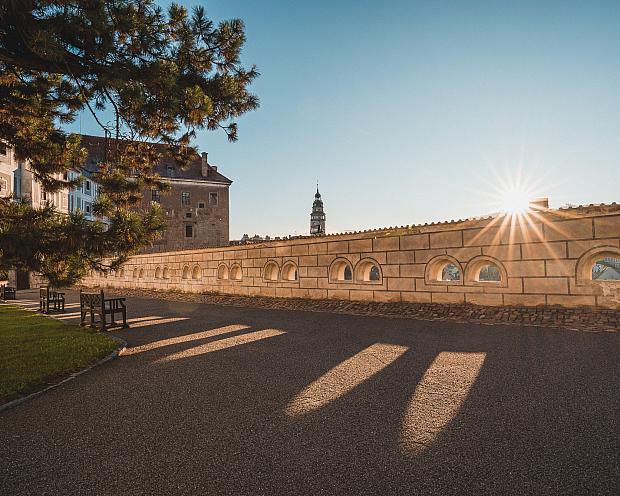
Castle Garden
An integral and the most extensive part of the castle grounds, the Baroque garden was founded in the 17th century. It lies on a hill, on a plot in the shape of an elongated rectangle measuring approximately 150 x 750 metres. The total area is 10,875 hectares. The whole area of the castle garden is surrounded by a fence wall. Parts of the garden:
- The terrace of the so-called summer riding school – a rectangular space lined with mature linden trees, in the past used as a training ground for horseback riding, adjacent to it is the building of the riding school.
- Terrace of the so-called lower parterre – a large roughly square area with a hint of renovated Rococo elements, in the upper part there is a Rococo cascade fountain
- Terrace of the so-called upper garden – an approx. 500-metre long and 150-metre wide area with now mostly free landscaping. Here you will find a square castle pond in the back and the buildings of the Bellarie Summer Palace (in front of it there is a revolving auditorium) and the Music Pavilion.
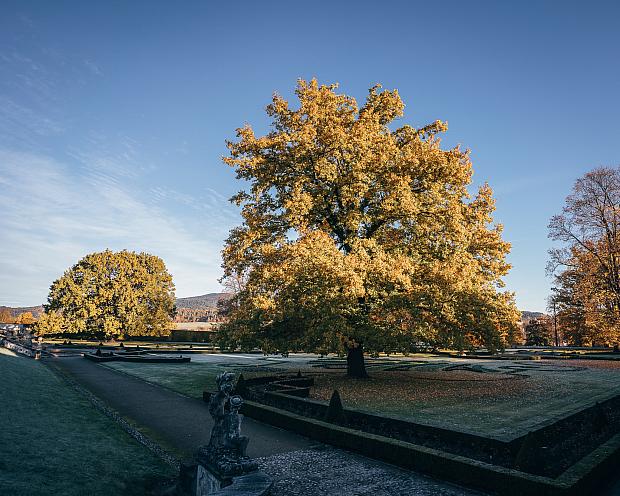
- sights
- suitable for children
- architecture
- history
